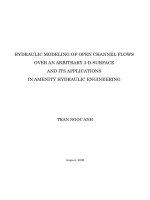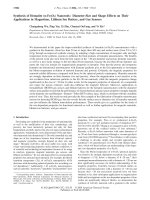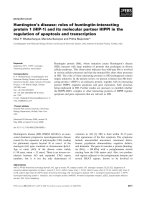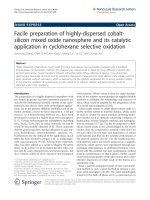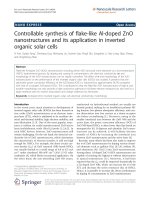Synthesis of zr beta zeolite in fluoride medium and its applications in catalytic liquid phase reactions
Bạn đang xem bản rút gọn của tài liệu. Xem và tải ngay bản đầy đủ của tài liệu tại đây (1.47 MB, 224 trang )
SYNTHESIS OF ZR-BETA ZEOLITE IN FLUORIDE MEDIUM
AND ITS APPLICATIONS IN CATALYTIC LIQUID-PHASE
REACTIONS
BY
ZHU YONGZHONG
(M. Eng. DUT)
A THESIS SUBMITTED
FOR THE DEGREE OF DOCTOR OF PHILOSOPHY
DEPARTMENT OF CHEMISTRY
NATIONAL UNIVERSITY OF SINGAPORE
JUNE, 2004
i
Acknowledgments
First and foremost, I would like to express my deepest gratitude to my supervisor,
Associate Professor, S. Jaenicke, for giving me the opportunity to work in his laboratory.
Without his enthusiasm, guidance, patience and understanding, this research work would not
have been possible.
I am also grateful to Associate Professor, G. K. Chuah, for her invaluable advice and
guidance. Thanks also go to
my co-supervisor Associate Professor, A/P H. C. Zeng for his
kind support in XPS measurement. Appreciation also goes to my labmates, particularly
Shuhua, Gao Lu, Yuntong, Eeling, Wang Xu, Yuanqin, Yang Hua for their help and
encouragement.
Financial support for my research from National University of Singapore is gratefully
acknowledged.
Last but not least I would like to thank my wife, Dai Xueni, my son, Zhu Qi, and my
parents-in-law for their love, understanding, invaluable encouragement and moral support.
ii
Table of Contents
Pg No
Acknowledgment
I
Table of contents
II
Summary
VII
List of publications
X
List of tables
XII
List of schemes
XIV
List of figures
XVI
List of abbreviations
XX
Chapter 1 Introduction
1
1.1. General introduction
1.2. Synthesis of zeolite beta
1.2.1. Synthesis of zeolite beta in basic medium
1.2.2. Synthesis of zeolite beta in fluoride medium
1.2.3. Incorporation of other metal elements into zeolite beta
1.2.4. Synthesis mechanism of zeolite beta
1.2.5. Structure of zeolite beta
1.3. Modification of zeolite
1.3.1. Tuning hydrophilic/hydrophobic property of zeolite
1.3.2. Introduction of Brønsted and Lewis acidity
1.3.3. Introduction of metal and metal complexes
1.3.4. High temperature treatment
1.3.5. Inertization of external surface of zeolites
1.4. Applications of zeolite beta in organic reactions
1.4.1. Alkylation
1.4.2. Acylation
1.4.3. The Fries Rearrangement
1
2
2
3
4
7
8
9
9
10
12
13
13
14
15
16
17
iii
1.4.4. Meerwein-Ponndorf-Verley (MPV) reduction and Oppenauer
oxidation
1.4.5. Oxidation reactions
1.4.5.1. Titanium containing zeolite beta
1.4.5.2. Al-Free Sn-beta as Baeyer-Villiger oxidation catalyst
1.5. Aims of the present study
References
18
20
20
21
22
Chapter 2 Experimental
2.1. Materials
2.1.1. Preparation of zeolite beta seeds
2.1.2. Synthesis of Al-free Zr-beta zeolite
2.1.3. Synthesis of Al-containing Zr-beta zeolite
2.1.4. Synthesis of Ti-beta zeolite
2.1.5. Synthesis of Al- and Sn-beta zeolites
2.1.6. Synthesis of Al-beta sample in basic medium
2.1.7. Synthesis of Zr-SBA-15
2.2. Characterization
2.2.1. X-ray diffraction (XRD)
2.2.2. Infrared spectroscopy (IR)
2.2.3. Pyridine-adsorption IR
2.2.4. 4-Methylcyclohexanone-adsorption IR
2.2.5. Solid state nuclear magnetic resonance (NMR) spectroscopy
2.2.6. N
2
adsorption
2.2.7. Thermogravimetric analysis (TGA)
2.2.8. Scanning electron microscopy (SEM)
2.2.9. X-ray photoelectron spectroscopy (XPS)
2.3. Catalytic experiments
2.3.1. Meerwein-Ponndorf-Verley (MPV) reduction
2.3.2. Oppenauer oxidation
2.3.3. Catalytic cyclisation of citronellal
2.3.4. Synthesis of (S)-1-phenylethanol and (R)-1-phenylethyl acetate
36
36
36
36
37
37
38
38
39
40
40
41
42
43
43
45
46
46
47
48
48
49
50
50
iv
2.3.5. Racemization of (S)-1-phenylethanol
2.3.6. General procedure for the dynamic kinetic resolution of 1-
phenylethanol
References
51
51
53
Chapter 3 Synthesis and characterization of Zr-beta zeolite in fluoride
medium
3.1. Introduction
3.2. Results and discussion
3.2.1. Synthesis of Zr-beta zeolite in fluoride medium
3.2.2. Powder X-ray diffraction
3.2.3.
29
Si MAS NMR spectroscopy
3.2.4. FTIR spectroscopy
3.2.4.1. Framework vibration region
3.2.4.2. OH stretching region
3.2.4.3. Pyridine adsorption
3.2.5. Scanning electron microscopy (SEM)
3.2.6. N
2
adsorption
3.2.7. X-ray photoelectron spectroscopy (XPS)
3.2.8.
13
C CP MAS NMR and thermogravimetic analysis
3.3. Conclusions
References
55
55
58
58
59
61
62
62
64
65
66
67
67
68
69
70
Chapter 4 Zr-beta zeolite as a regioselective catalyst in the Meerwein-
Ponndorf-Verley reduction
4.1. Introduction
4.2. Results and discussion
4.2.1. Catalyst characterization
4.2.2. Catalytic activity of various metal substituted zeolite beta
4.2.3. Reuse of Zr-beta zeolite
4.2.4. Influence of zeolite calcination temperature
4.2.5. Influence of crystal size of Zr-beta zeolite
4.2.6. Influence of different reducing agents on the catalytic performance
86
86
89
89
90
92
93
93
93
v
4.2.7. Influence of the molecular structure of the substrate
4.2.8. Influence of acid, base and water on the catalyst activity
4.3. Conclusions
References
94
97
100
101
Chapter 5 Selective reduction of α,β-unsaturated aldehydes to the
corresponding unsaturated alcohols over Zr-beta zeolite
5.1. Introduction
5.2. Results and discussion
5.2.1. Catalyst characterization
5.2.2. MPV of cinnamaldehyde over Zr-beta
5.2.3. Poisoning test and catalyst stability
5.2.4. Catalyst deactivation and recycling
5.2.5. Selective reduction of other α,β-unsaturated aldehydes
5.3. Conclusions
References
115
115
118
118
120
123
125
126
127
128
Chapter 6 Liquid-phase Oppenauer oxidation of alcohols over Zr-beta
zeolite
6.1. Introduction
6.2. Results and discussions
6.2.1. Effect of the oxidants
6.2.2. Effect of Si/Zr ratio in Zr-beta zeolite
6.2.3. Effect of ratio of furfural to substrate
6.2.4. Oppenauer oxidation of other alcohols with furfural
6.2.5. Oppenauer oxidation of 4-tert-butylcyclohexanol with 2-butanone
6.3. Conclusions
References
141
141
143
143
144
145
145
146
148
149
Chapter 7 Zr-beta zeolite as diastereoselective heterogeneous Lewis-acid
catalyst for cyclisation of citronellal to isopulegol
7.1. Introduction
7.2. Results and discussion
7.2.1. Cyclisation of citronellal over Zr-beta zeolite
156
156
160
160
vi
7.2.2. Effect of metal substitution in zeolite beta catalysts
7.2.3. Effect of solvent
7.2.4. Effect of reaction temperature
7.2.5. Effect of catalyst amount
7.2.6. Stability of Zr-beta catalyst
7.2.7. Reaction mechanism
7.3. Conclusions
References
161
161
162
164
164
164
167
168
Chapter 8 Dynamic kinetic resolution of secondary alcohols combining
enzyme-catalyzed transesterification with zeolite-catalyzed racemization
8.1. Introduction
8.2. Results and discussion
8.2.1. Racemization of (S)-1-phenylethanol
8.2.2. Dynamic kinetic resolution (DKR) of 1-phenylethanol in one pot
8.2.3. Effect of solvents
8.2.4. Effect of temperature
8.2.5. Re-use of Zr-beta catalyst
8.2.6. DKR of some other secondary alcohols
8.3. Conclusions
References
176
176
180
180
181
184
185
186
186
188
189
vii
Summary
Zeolite beta is one of the few large-pore high-silica zeolites with a three-dimensional
pore structure containing 12-membered apertures, which makes it a very suitable and
regenerable catalyst for the production of fine chemicals in liquid phase reactions. The
objective of this study is to study the synthesis and characterization of Al-free Zr-beta in
fluoride medium, and to apply the as-made Zr-beta zeolite in catalytic liquid phase
reactions.
Al-free Zr-beta zeolite has been synthesized for the first time in the presence of F
-
and
TEA
+
at near neutral pH. The incorporation of zirconium into the framework of zeolite
beta greatly prolonged the crystallization time. In the presence of dealuminated beta
seeds, pure and well crystallized samples of zeolite beta could be obtained with Si/Zr
ratio in the range from 84 to infinity, whereas in the unseeded synthesis the lowest Si/Zr
ratio was 102. The size of the crystals of Zr-beta zeolite was greatly influenced by the
seeds. Bigger crystal size was obtained in the unseeded system. Characterization of the
materials with XRD, IR and
29
Si MAS NMR showed an increased resolution of the
patterns when decreasing the zirconium content. This is due to the absence of
connectivity defects and also to the higher degree of order in the absence of zirconium.
The incorporation of zirconium into the framework also induced the preference for the
stacking sequence of polymorph B as observed in the XRD patterns. IR spectra of
adsorbed pyridine showed that Lewis acidity was predominant in Zr-beta zeolite samples.
Zr-beta zeolite was found to be a regioselective catalyst for the Meerwein-Ponndorf-
Verley (MPV) reduction of 4-tert-butylcyclohexanone to cis-4-tert-butylcyclohexanol.
viii
The excellent performance of Zr-beta zeolite in the this reaction is due to an appropriate
Lewis acidity and the ease of ligand exchange at the Zr active sites within the zeolite beta
pore channels. The observed high selectivity (cis:trans>99%) to the thermodynamically
less stable cis-alcohol is suggested to result from transition-state selectivity. Another
prominent feature of Zr-beta zeolite catalyst is its ability to maintain activity even in the
presence of rather significant amounts of water, up to 9 wt %. The activity was slightly
affected by the presence of pyridine, but was decreased by added acids. However, the
poisoning effect could be easily reversed by washing.
Zr-beta zeolite was also found to be a chemoselective catalyst for the MPV reduction
of cinnamaldehyde to cinnamyl alcohol. The active sites were again considered to be the
Lewis acid zirconium sites which are located in the micropores of the zeolite. For Al-free
Zr-beta zeolite samples, excellent conversion was always paired with high selectivity. In
contrast, Al-containing Zr-beta samples were not as active as Al-free Zr-beta samples.
High chemoselectivity was also observed in the Oppenauer oxidation of cinnamyl alcohol
to cinnamaldehyde over Zr-beta zeolite.
Zr-beta zeolite showed high stereoselectivity in the cyclisation of citronellal to
isopulegol. The diastereoselectivity, up to 93%, obtained in this study is perhaps the
highest among all heterogeneous catalysts reported for this reaction. The influence of
solvents and temperature on the activity of Zr-beta zeolite was studied. A tentative
reaction mechanism for the cyclisation of citronellal to isopulegol was proposed.
In the last part of this thesis, several metal-substituted beta zeolites were studied as
heterogeneous racemization catalyst. Zr-beta was found to be the best for (S)-1-
phenylethanol racemization. The coupling of Zr-beta zeolite catalyzed racemization with
ix
the enzyme catalyzed resolution of 1-phenylethanol was possible in one pot. Under
optimized conditions, more than 93% conversion with an ee value of 83% was achieved
at 60 ºC with toluene as solvent. While the ee value is not yet fully satisfactory, the
outcomes demonstrate the validity of the concept of a one-pot dynamic resolution over a
cheap and robust racemising agent.
x
List of Publications
Journal papers
1. Supported zirconium propoxide—a versatile heterogeneous catalyst for the
Meerwein–Ponndorf–Verley reduction
Y. Z. Zhu, S. Jaenicke, and G. K. Chuah
J. Catal. 218 (2003) 396
2. Al-free Zr-zeolite beta as a regioselective catalyst in the Meerwein–Ponndorf–
Verley reaction
Y. Z. Zhu, G. K. Chuah, and S. Jaenicke
Chem. Commun. (2003) 2734.
3. Chemo- and regioselective Meerwein-Ponndorf-Verley and Oppenauer reactions
catalysed by Al-Free Zr-zeolite beta
Y. Z. Zhu, G. K. Chuah, and S. Jaenicke
J. Catal. 227 (2004) 1
4. Zirconia catalysts in Meerwein-Ponndorf-Verley reduction of citral
Y. Z. Zhu, S. H. Liu, S. Jaenicke, and G. K. Chuah
Catal. Today 97 (2004) 249
5. Process intensification with biocatalysts: dynamic kinetic resolution and fluorous
phase switch with continuous extraction
E. L. Teo, G. K. Chuah, A. R. J. Huguet, S. Jaenicke, G. Pande, and Y. Z. Zhu
xi
Catal. Today 97 (2004) 263
6. Cyclisation of Citronellal over Zirconium Zeolite Beta – A Highly
Diastereoselective Catalyst to (±)-Isopulegol
Y.Z. Zhu, Y.T. Nie, G. K. Chuah, and S. Jaenicke
J. Catal. XXX (2005) XXX (in press).
Conference papers
1. Zirconium propoxide grafted SBA-15 catalysts for chemo-selective reductions
Y. Z. Zhu and S. Jaenicke
(Poster at the Singapore International Chemical Conference-2 (SICC-2), P65,
Dec., 2001, Singapore)
2. Hydrous zirconia as a selective catalyst for the Meerwein-Ponndorf-Verley
reduction
S. H. Liu, Y. Z. Zhu
, and G. K. Chuah
(Scientific Collaborations in Catalysis Research. Dec. 2002, Netherlands)
3. Catalytic Meerwein-Ponndorf-Verley reduction of cinnamaldehyde and
Oppenauer oxidation of cinnamyl alcohol by Zr-beta zeolite
Y. Z. Zhu, G. K. Chuah, and S. Jaenicke
(Poster at the Singapore International Chemical Conference-3 (SICC-3), P27,
Dec., 2003, Singapore)
xii
List of Tables
Pg No
Table 1-1 Hydrophobicity index for zeolite beta with various Si/Al ratios
[38].
30
Table 2-1 Infrared bands of pyridine on acid solids in the 1400-1700 cm
-1
region
a
.
52
Table 3-1 Synthesis of Zr-beta zeolite in fluoride medium. 74
Table 3-2 Characteristic N
2
adsoption/desorption data for calcined Zr-beta
zeolite samples
74
Table 4-1 Physical properties of zeolite beta samples tested in MPV
reactions.
103
Table 4-2 MPV reduction of 4-tert-butylcyclohexanone over various
zeolite beta catalysts.
104
Table 4-3 Zr-Beta Zeolite before and after MPV Reduction of 4-tert-
butylcycohexanone.
104
Table 4-4 Reduction of 4-tert-butylcyclohexanone over Zr100 with various
secondary alcohols.
105
Table 4-5 MPV reduction of alkyl cyclohexanones with 2-propanol over
Zr100 and Zr-SBA-15.
106
Table 4-6 MPV reduction of different substrates over Zr100. 107
Table 5-1 Chemical and textural properties of Zr-beta zeolite samples
tested in MPV reactions.
132
Table 5-2 MPV reduction of cinnamaldehyde over various catalysts. 132
Table 5-3 Influence of water, base, and acid on the catalytic activity of Zr-
beta in the MPV reduction of cinnamaldehyde.
133
Table 5-4 MPV reduction of various α,β-unsaturated aldehydes over Zr-
beta
134
Table 6-1 Oppenauer oxidation of cinnamyl alcohol with various oxidants
over Zr-beta zeolite sample Zr100.
150
Table 6-2 Oppenauer oxidation of various alcohols with furfural. 151
xiii
Table 7-1 Cyclisation of citronellal over Zr-beta zeolite. 170
Table 7-2 Cyclisation of citronellal to isopulegol over various catalysts. 170
Table 7-3 Effect of solvents on the cyclisation of citronellal to isopulegol
over Zr-beta zeolite.
171
Table 7-4 Effect of reaction temperature on the cyclisation of citronellal to
isopulegol.
171
Table 7-5 Effect of catalyst amount on the cyclisation of citronellal to
isopulegol.
172
Table 7-6 Effect of water on the activity of Zr-beta. 172
Table 8-1 Racemization of (S)-1-phenylethanol in toluene. 192
Table 8-2 Effect of solvents on the DKR of 1-phenylethanol. 193
Table 8-3 Effect of temperature on the DKR of 1-phenylethanol 194
Table 8-4 DKR of several other secondary alcohols 195
xiv
List of Schemes
Pg No
Scheme 1-1 Isopropylation of naphthalene. 31
Scheme 1-2 Acylation of anisole and veratrole. 31
Scheme 1-3 H-beta catalyzed acylation of 2-methoxynaphthalene. 31
Scheme 1-4 Synthesis of 2,4-dihydroxybenzophenone through Fries
rearrangement.
32
Scheme 1-5 MPV reduction of 4-tert-butylcyclohexone: proposed transition
states for cis- and trans- 4-tert-butylcyclohexnol.
32
Scheme 4-1 Reaction mechanism for the MPVO reaction. 108
Scheme 4-2 Transition state for the formation of cis-4-t-butylcyclohexanol
(left) and tans-4-t-butylcyclohexanol (right).
108
Scheme 5-1 The reaction pathways in the hydrogenation of α,β-unsaturated
aldehydes
135
Scheme 5-2 MPV reduction of α,β-unsaturated aldehydes [16]. 135
Scheme 5-3 The reaction pathway for the MPV reduction of cinnamaldehyde
over Zr-beta zeolite
135
Scheme 6-1 Reaction mechanism of the Oppenauer oxidation. 152
Scheme 6-2 Aldol condensation of aldehydes containing α-hydrogen. 152
Scheme 6-3 Tishchenko reaction between two aldehydes without α-
hydrogen.
152
Scheme 6-4 Oppenauer oxidation of 4-tert-butylcyclohexanol. 152
Scheme 7-1 The production of (-)-menthol by Lewis-acid catalysed
cyclisation of (+)-citronellal with subsequent catalytic
hydrogenation.
173
Scheme 7-2 Proposed reaction mechanism for the cyclisation of citronellal to
isopulegol.
173
Scheme 8-1 Kinetic resolution of a secondary alcohol. 196
Scheme 8-2 Dynamic kinetic resolution of a racemic compound. 196
Scheme 8-3 Proposed mechanism for the racemizaion of (S)-1-phenylethanol 197
xv
over Zr-beta zeolite.
Scheme 8-4 Expected pathway for DKR of 1-phenylethanol 197
xvi
List of Figures
Pg No
Figure 1-1 Typical zeolite pore sizes illustrated with oxygen packing
models.
33
Figure 1-2 Projections along principal crystallographic directions of zeolite
beta structures: (a) polymorph A and (b) Polymorph B. The unit
cell outlines are indicated by the dashed lines.
34
Figure 1-3 Pore sizes of zeolite beta: (a) 12-ring viewed along [100] and (b)
12-ring viewed along [001].
34
Figure 1-4 Brønsted acid site in zeolite framework with a proton on a
bridging Al-O-Si
35
Figure 1-5 Proposed mechanism for Baeyer-Villiger oxidation with
hydrogen peroxide over Al-free Sn beta.
35
Figure 3-1 Influence of Si/Zr ratio on the synthesis of Zr-beta. 75
Figure 3-2 X-ray diffraction patterns of as-made (a) and calcined (b) Zr-
beta zeolite samples Zr100.
75
Figure 3-3 XRD diffraction pattern of calcined Zr-beta at low 2θ range. 76
Figure 3-4 Intensity of simulated powder X-ray diffraction patterns versus
diffraction angle (2θ) of the BEA-'Polymorph B' series in steps
of 10% intergrowth.
77
Figure 3-5 X-ray diffraction patterns of Zr-beta zeolite sample Zr100
calcined at: (a) 580 ºC, (b) 750ºC, and (c) 900 ºC.
78
Figure 3-6
29
Si MAS NMR of calcined Zr-beta zeolite and pure Si-beta
samples: (a) Zr75, (b) Zr100, (c) Zr200, and (d) Si-beta.
79
Figure 3-7 Infrared spectra in the framework vibration region of as-made
Zr-beta zeolite samples and one beta sample synthesized in basic
medium
80
Figure 3-8 Infrared spectra in the framework vibration region of calcined
Zr-beta zeolite samples and one beta sample synthesized in basic
medium
80
xvii
Figure 3-9 Infrared spectra in the OH vibration region of calcined Zr-beta
zeolite samples and one beta sample synthesized in basic
medium.
81
Figure 3-10 Infrared spectra of pyridine adsorption at 25 ºC and desorption at
25 ºC (a), 100 ºC (b), and 200 ºC (c) on calcined Zr-beta zeolite
sample Zr100.
81
Figure 3-11 Infrared spectra of pyridine adsorption (at 25 ºC) and after
desorption at 100 ºC over Zr-beta zeolite samples and one Al-
beta sample.
82
Figure 3-12 SEM images of Zr-beta zeolite synthesized in the fluoride
medium.
83
Figure 3-13 X-ray photoelectron spectroscopy of calcined Zr-beta zeolite
sample Zr100.
84
Figure 3-14
13
C CP MAS NMR of uncalcined Zr-beta zeolite sample Zr100. 84
Figure 3-15 Thermogravimetric analysis of uncalcined Zr-beta zeolite
samples: (a) Zr75, (b) Zr100, and (c) Zr200.
85
Figure 4-1 XRD patterns of the calcined catalysts. 109
Figure 4-2 IR spectra of pyridine adsorption (at 25 ºC) and desorption at
100 ºC over: (a) Si-beta, (b) Sn-beta (Si/Sn=125), (c) Ti-beta
(Si/Ti=100), (d) Zr-beta (Si/Zr=107), and (e) H-beta
(Si/Al=12.5).
109
Figure 4-3 IR Spectra of 4-methylcyclohexanone adsorption at 25 ºC and
desorption at 25, 50, 100, and 200 ºC over Zr75 (a), Zr100 (b),
Zr200 (c), and Si-beta (d).
110
Figure 4-4 IR Spectra of 4-methylcyclohexanone adsorption (at 25 ºC) and
desorption at 25, 50, 100, and 200 ºC over Zr-beta (a), Sn-beta
(b), Ti-beta (c), and H-beta (d).
111
Figure 4-5 Influence of zeolite calcination temperature on the MPV
reduction of 4-tert-butylcyclohexanone.
112
Figure 4-6 Influence of crystal size of Zr-beta on the MPV reduction of 4-
tert-butylcyclohexanone.
112
xviii
Figure 4-7 Conversion of 4-tert-butylcyclohexanone with added base and
acids
113
Figure 4-8 Conversion of 4-tert-butylcylohexanone over (a) Zr100 and (b)
Sn125 – (○) without water and in the presence of added water:
(■) 0.6 w t%, (▲) 2.9 wt%, and (●) 9.1 wt %.
114
Figure 5-1 XRD patterns of calcined: (a) Zr100, (b) ZrAl100, and (c)
ZrAl25.
136
Figure 5-2 IR spectra of pyridine adsorption at 25 ºC and desorption at 100
ºC over: (a) Zr100, (b) ZrAl100, and (c) ZrAl25.
136
Figure 5-3
29
Si MAS NMR of calcined: (a) Zr100, (b) ZrAl100, and (c)
ZrAl25.
137
Figure 5-4 MAS NMR of calcined: (a) Zr100, (b) ZrAl100, and (c) ZrAl25. 137
Figure 5-5 MPV reduction of cinnamaldehyde over Al-free Zr-beta zeolite. 138
Figure 5-6 MPV reduction of cinnamaldehyde over Al-containing Zr-beta
zeolite (dashed lines and open symbols refer to selectivity).
138
Figure 5-7 Influence of water on the MPV reduction of cinnamaldehyde
over Zr-beta.
139
Figure 5-8 Influence of base and acid on the MPV reduction of
cinnamaldehyde over Zr-beta.
139
Figure 5-9 Recycling tests of Zr-beta in the MPV reduction of
cinnamaldehyde.
140
Figure 6-1 Effect of oxidants on the Oppenauer oxidation of cyclohexanol
to cyclohexanone over Zr-beta zeolite.
153
Figure 6-2 Oppenauer oxidation of cinnamyl alcohol over Zr-beta zeolite 153
Figure 6-3 Oppenauer oxidation of cyclohexanol over Zr-beta zeolite. 154
Figure 6-4 Oppenauer oxidation of cinnamyl alcohol over Zr-beta zeolite
with different furfural/cinnamyl alcohol ratio: (■) 6:1, (●) 2:1,
and (▲) 1:1.
154
Figure 6-5 Oppenauer oxidation of cyclohexanol over Zr-beta zeolite with
different furfural/cyclohexanol ratio.
155
xix
Figure 6-6 Oppenauer oxidation of 4-tert-butylcyclohexanol with 2-
butanone over Zr100.
155
Figure 7-1 Plots of –ln(1-X
A
) again reaction time over Zr-beta (Si/Zr=107). 174
Figure 7-2 Arrhenius plot of lnk vs 1/T. 175
Figure 7-3 Plot of k vs catalyst amount. 175
Figure 8-1 Gas chromatograms of (a) after 1 hour and (b) after 48 hours. 198
Figure 8-2 Dynamic kinetice resolution of 1-phenylethanol in one pot. 199
Figure 8-3 Influence of acetophenone on the DKR of 1-phenylethanol. 200
Figure 8-4 DKR of 1-phenylethanol at different temperatures: (●) 50 ºC,
(▲) 60 ºC, (■) 70 ºC, and (♦) 80 ºC.
201
Figure 8-5 Reuse of Zr-beta on the DKR of 1-phenylethanol. 202
xx
List of Abbreviations
BET Brunauer-Emmett-Teller
BJH Barrett-Joyner-Halenda
CALB Candida Antarctica lipase B
CTR Cathode ray tube
CP Cross-polarization
DABCO 1,4-Diazabicyclo [2,2,2] octane
DBDMA Dibenzyldimethylammonium
DKR Dynamic kinetic resolution
ee
enantiomeric excess
ESCA Electron spectroscopy for chemical analysis
FID Flame ionization detector
FTIR Fourier transform infrared spectroscopy
GC Gas chromatography
HPLC High performance liquid chromotography
IR Infrared spectroscopy
KR Kinetic resolution
MAS Magic angle spinning
MPV Meerwein-Ponndorf-Verley
MPVO Meerwein-Ponndorf-Verley-Oppenauer
NMR Nuclear magnetic resonance
SDA Structure directing agents
SEM Scanning electron microscopy
TBME tert-butyl methyl ether
TEAOH Tetraethylammonium hydroxide
TEOS Tetraethylorthosilicate
TGA Thermogravimetric analysis
TMS Trimethylsilane
TOF Turnover frequency
xxi
TON Turnover number
XPS X-ray photoelectron spectroscopy
XRD X-ray diffraction
u.c. Unit cell
1
Chapter 1
Introduction
1.1 General introduction
Zeolites are crystalline aluminosilicates whose lattice consists of a network of SiO
4
4-
and AlO
4
5-
tetrahedra with Si or Al atoms (collectively denoted T atoms) at the centers
and oxygen atoms in each corner [1]. A network of SiO
4
4-
tetrahedra is neutral while each
AlO
4
5-
tetrahedron in the framework bears a net negative charge which is balanced by a
cation (Na
+
, K
+
, or NH
4
+
) that resides in the interstice of the framework. Zeolite crystals
are porous at the molecular level. Their framework structure contains channels and voids
with dimensions between 4 and 14 Å, which is similar to the size of small organic
molecules. Typical zeolite pore size using oxygen-packing models are shown in Figure 1-
1. They include small pore zeolites with 8-ring pores with free diameters of 3-4.5 Å, e.g.,
zeolite A; medium pore zeolites with 10-ring pores, 4.5-6.0 Å, e.g., zeolite ZSM-5; large
pore zeolites with 12-ring pores with 6-8 Å, e.g., zeolite X and Y; and extra-large pore
zeolites with 14-ring pores, e.g., zeolite UTD-1. The chemical properties of zeolites
combined with their structural architecture have led to many applications in catalysis, ion
exchange, and gas adsorption. It is possible to say that zeolites are the most widely used
heterogeneous catalysts in industry.
Compared to the successful use of zeolites in hydrocarbon processing, their use in the
synthesis of organic intermediates and fine chemicals is in a relatively early state of
development. Two main reasons for this are: 1) many organic intermediates and fine
chemicals are too bulky to be built in or to desorb from the zeolite pore systems; 2) the
2
average synthetic organic chemist is not sufficiently acquainted with zeolites, their
handling and tuning and their potential, other than their use as drying agent.
In the last decades it has been recognized that zeolite beta is one of the few large pore
high-silica zeolites with a three-dimentional pore structure containing 12-membered ring
apertures [2-4]. This makes zeolite beta a very suitable and regenerable catalyst in
organic reactions, where high thermal and hydrothermal stability and low steric
restrictions can be of paramount importance. Therefore, the study of using zeolite beta in
the production of organic intermediates and fine chemicals would be significant.
1.2 Synthesis of zeolite beta
1.2.1 Synthesis of zeolite beta in basic medium
Zeolite Beta was first synthesized by Wadlinger et al. in 1967 [5]. In their pioneering
work, zeolite beta was prepared from basic media (without F
-
) in the presence of Na
+
and
TEA
+
cations as the template. Amorphous silica or silica sol was employed as silica
sources and metallic aluminum or sodium aluminate as aluminum sources. The
crystallization was carried out at 150°C in an autoclave under static conditions for 3- 6
days. The molar ratios of Si/Al in the recovered product were in the range 5-100. Later on,
the use of other templating agents such as 1,4-diazabicyclo [2,2,2] octane (DABCO) [6]
or dibenzyldimethylammonium cation [7] was also reported.
In general, the synthesis of zeolite beta with Si/Al ratio higher than 100 is rather
difficult in the basic medium. Nevertheless, the preparation of all-silica zeolite beta in
basic medium has been achieved by van der Waal et al. [8] in the presence of
dibenzyldimethylammonium cation as structure-directing agent, although the use of
dealuminated zeolite beta as seeds is required. At the low Si/Al side, the minimum Si/Al
3
ratio attained so far is 5 using TEA
+
as the template. Gusnet et al. [9] reported that a
substantial amount of non-framework aluminium in the low Si/Al materisls may be
present. However, the natural beta analogue Tschernichite possesses a Si/Al ratio of 3.
The mineral’s composition is Ca
0.97
Na
0.05
Mg
0.08
Al
2.0
Fe
0.02
Si
5.95
O
16.00
. This suggests that
nature used divalent cations (Ca
2+
) as the template, offering potential new routes to
zeolite beta.
1.2.2 Synthesis of zeolite beta in fluoride medium
The use of fluoride as a flux component for the crystal growth from a melt is well
known. On the other hand the mineralizing role of fluoride in hydrothermal synthesis was
known already to the ancient mineralogists and chemists, but until the end of the
seventies fluoride ions were never applied in the synthesis of microporous materials. The
first clear example of the use of fluoride was for crystallization of silicalite-1 in slightly
alkaline media by Flanigen and Patton [10]. After that, the fluoride route has been
extensively investigated, and many zeolites have been successfully synthesized in
fluoride medium.
The fluoride route has been applied to the synthesis of zeolite beta. Caullet et al. [11]
reported the synthesis of zeolite beta in fluoride medium using DABCO and methylamine
as templates. However, the method restricted the Si/Al ratio to a very narrow range
(Si/Al=9-22) and the presence of seeds was necessary to obtain a fully crystallized
material. It was also reported there that no zeolite beta was obtained using other
templates apart from DABCO in the fluoride medium. It could later be shown that
DABCO is not the only template to induce crystallization of zeolite beta. Camblor et al.
[12] carried out a detailed study on the synthesis of zeolite beta in a fluoride medium in
